SUMMARY
This is AI generated summarization, which may have errors. For context, always refer to the full article.
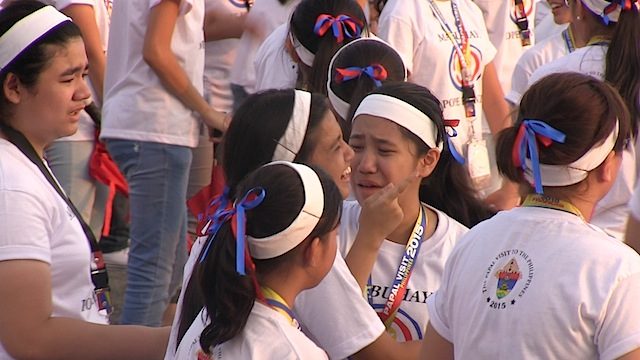
When Pope Francis arrived at the Villamor Air Base on January 15, even the priests raised their phones in the air to take a picture of him. It’s a proof that we were all there to witness a historic moment. The last time a pope visited the country, after all, was 20 years ago.
I saw how the country was electrified by the Pope’s presence. In the lens of my video camera from the media bleachers, I saw children crying when they saw him. I saw high-ranking government officials crowding around him and staring at him with awe – a look that I don’t think they had given even the President.
There were so many others who couldn’t help but run toward the red carpet, even if they weren’t part of the receiving line, to get a closer look at the Pope and to get pictures.
The air base was one big happy place.
I realized later that night, however, that I was not able to take a good look at the Pope myself. I was only looking at him through the screen of the video camera the whole time.
When someone asked how I felt when I saw him, I remember having difficulty adjusting the lens because it was around dusk when he arrived and it was the most difficult time to shoot.
At the Manila Cathedral the following day, I wasn’t at the media bleachers. Instead, I joined the crowd inside the square fronting the church. It was there that those phones in the air got me thinking.
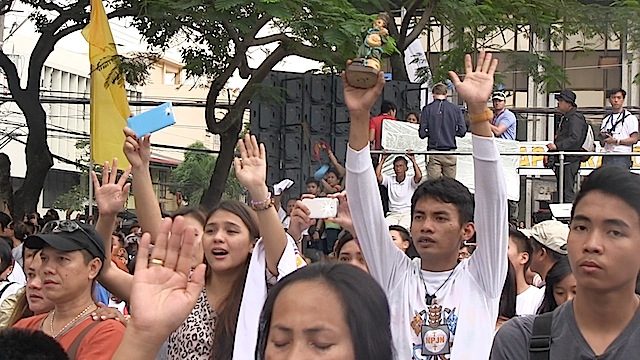
When these people raised their phones to get photos of the Pope as he passed them by, were they looking at their mobile screens the entire time? Was it more important to take that photo than to look at the Pope and, say, pray before him, or for these Catholics to marvel at his presence?
I decided at first I shouldn’t care so much. Photos are souvenirs they can keep for a lifetime.
But at the Manila Cathedral, I also heard people complaining about those phones. Every time people raised their phones, they were blocking the view of the people at the back and depriving them of the rare chance to see him, too.
I would later see videos of his motorcade, where the Pope would stop his car and then extend his hand to reach out to as many people as possible. In front of the Pope, I saw people smiling to their ears while their right or left hand stretched out to take photos or videos.
If your hand was busy holding your phone, do you think you have a better chance to hold the Pope’s hand than the those beside you who stretched both their hands out to him?
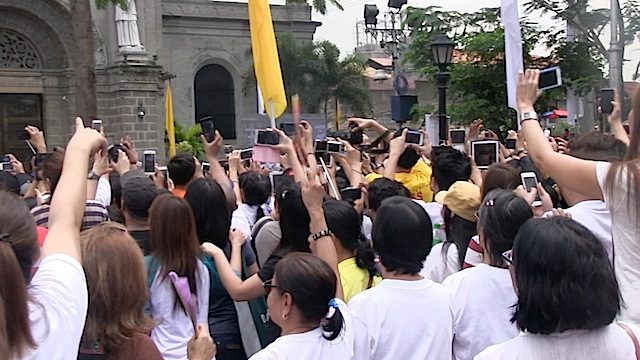
And then I saw a different group of people when I watched videos of the Pope going around Leyte on Day 3. It seemed to me it was more solemn. Or perhaps it was different when you’re on the ground.
There was a group of people at the Manila Cathedral who lingered at the square after the mass to watch the TV reporters at the media bleachers wrap up their coverage. When these people cheered in excitement and raised their phones to take photos, I wondered how different a sensation that was to them compared to their excitement when they got near the Pope earlier.
It made me sad to think of the possibility that, for some of them, it’s the same.
As I write this blog, I would read about the Pope’s message for the Catholic church’s World Day of Communications. He urged families to put aside their phones and social media accounts to spend time to talk to each other.
“The great challenge facing us today is to learn once again how to talk to one another, not simply how to generate and consume information,” the Pope said.
It’s a message we all who are obsessed with our phones should consider, Catholics and non-Catholics alike.
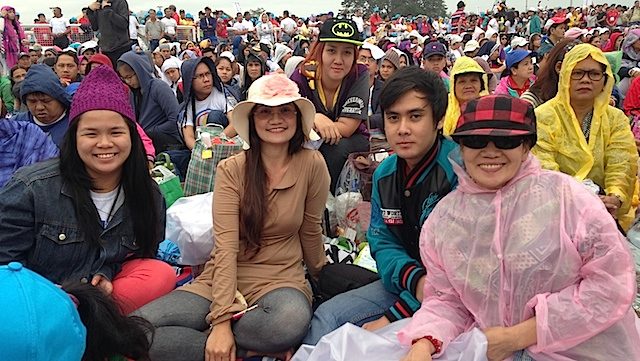
Perhaps even the priests were bothered by the phones themselves. Before the Pope arrived in Luneta for the concluding mass on Sunday, January 18, they announced repeated requests for the public to refrain from taking photos during the mass. It was to keep the solemnity of the event, the announcers explained.
And this is where I leave you with photos of improvised raincoats I saw in Luneta. I laugh looking at the photos now, but it wasn’t funny looking at them then.
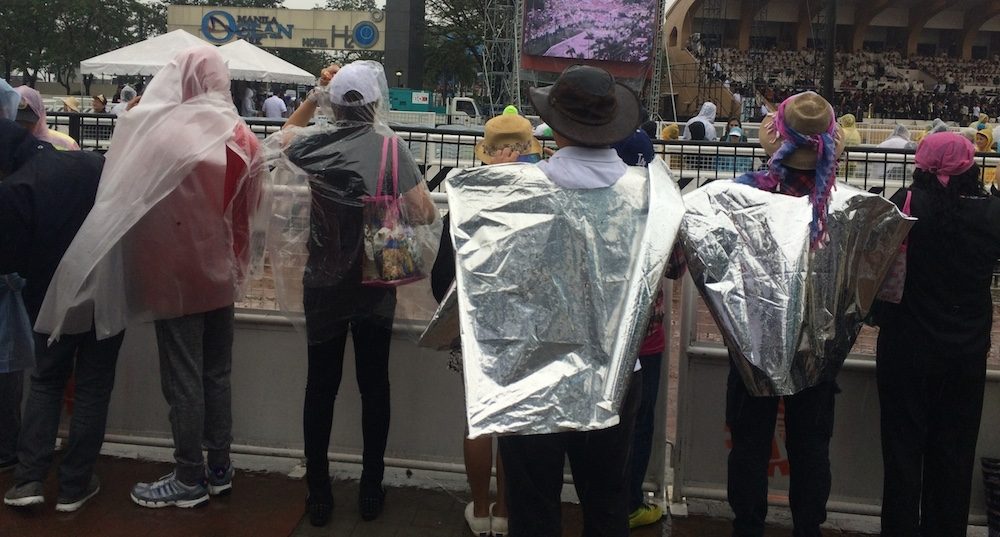
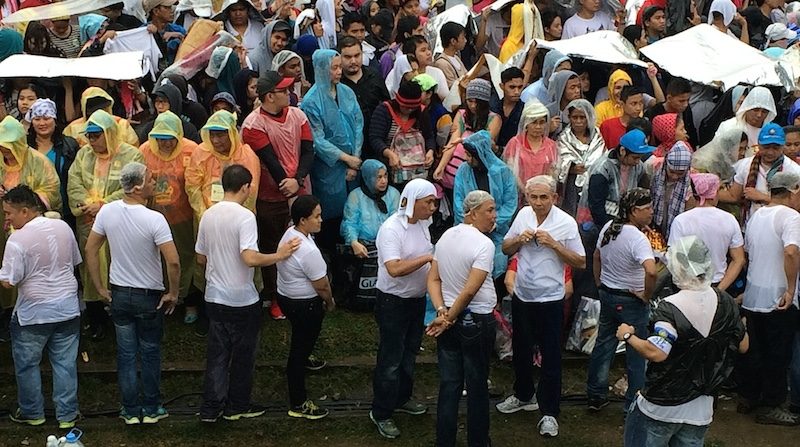
It was different in Leyte, where we saw a sea of yellow raincoats – the color of the Vatican. Apparently, the local churches provided those raincoats for their parishioners. While I felt sad for the the Leyteños because the storm forced Pope Francis to shorten his visit, it was to me a very poetic scene that showed the world how they suffer through storms many times of the year.
In Luneta, I felt bad for the people who didn’t have raincoats and stayed under the rain for hours. Many of them had camped outside the entrance gates as early as a day before the mass.
At the same time, I was inspired that in spite of their situation I did not see them complain about it. I had my own raincoat, but it was so cold I was shivering in the media bleachers. How much more difficult it must have been for them.
True to form, Filipinos set new crowd and social media records during the Pope’s visit. But beyond tweets and selfies, I wonder how Pope Francis changed the lives of the millions of Filipinos who waited in the streets, squeezed through thick crowds, and stood under the rain to see him.
I leave it to the religious experts to make conclusions about what the Pope’s visit meant to the Catholic church and its flock, the majority of the country’s 100 million population.
As a journalist, what I’m interested in is how his message against corruption and the reproductive health law will affect, if at all, government policies in the future. – Rappler.com
Add a comment
How does this make you feel?
There are no comments yet. Add your comment to start the conversation.